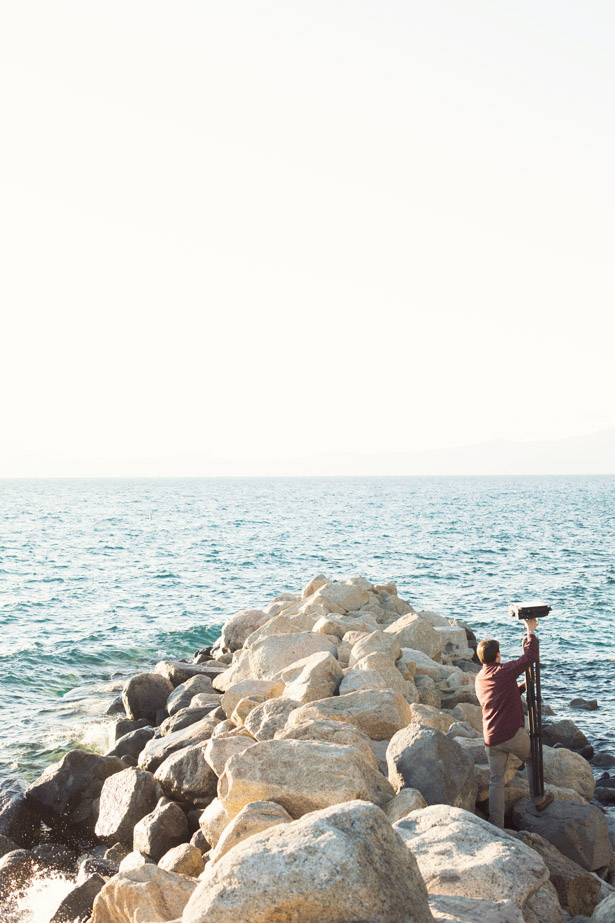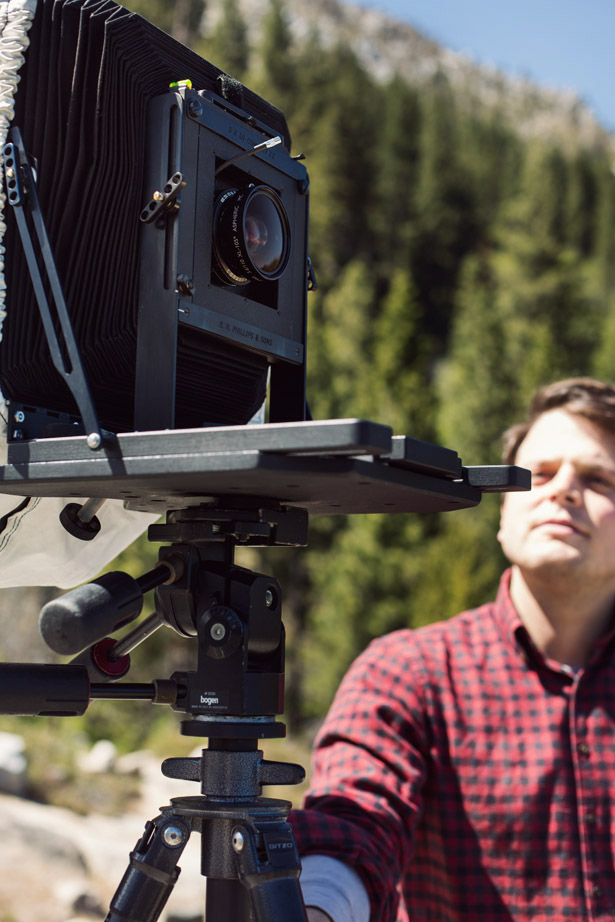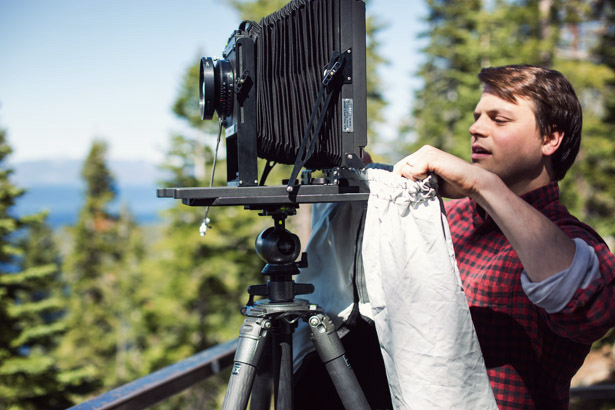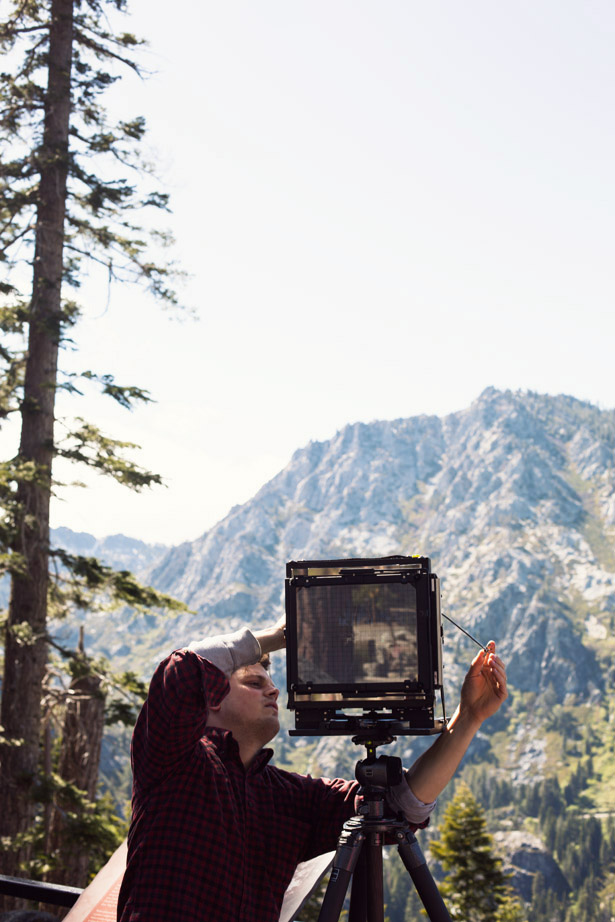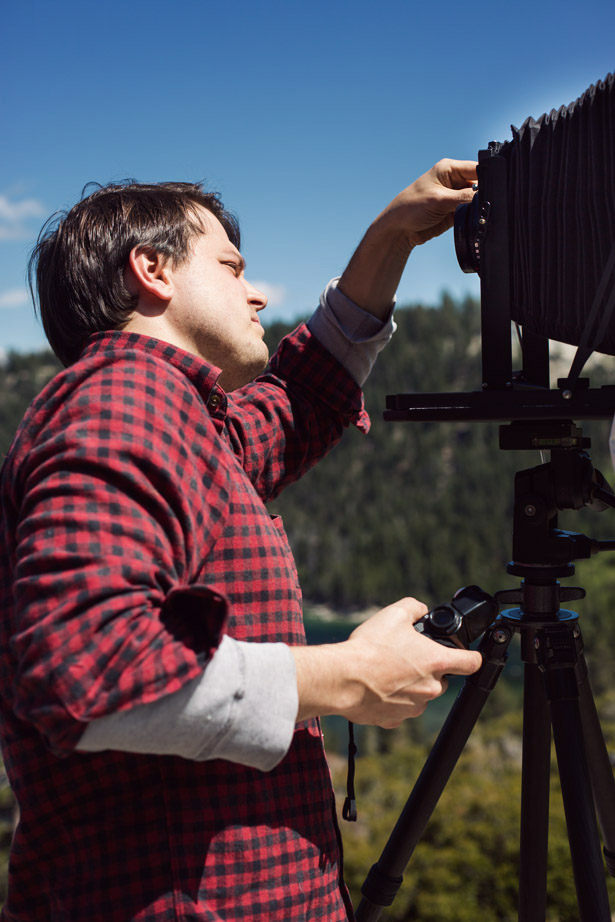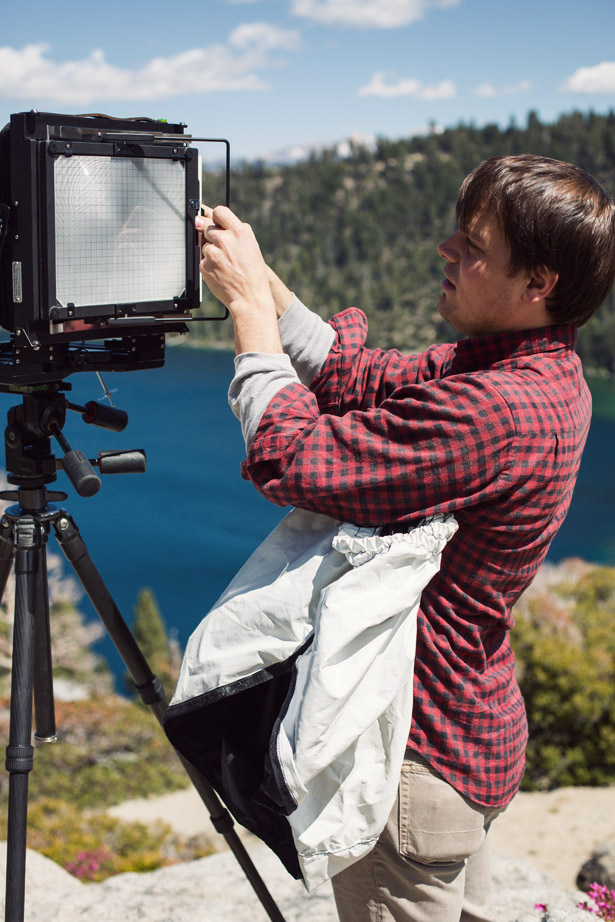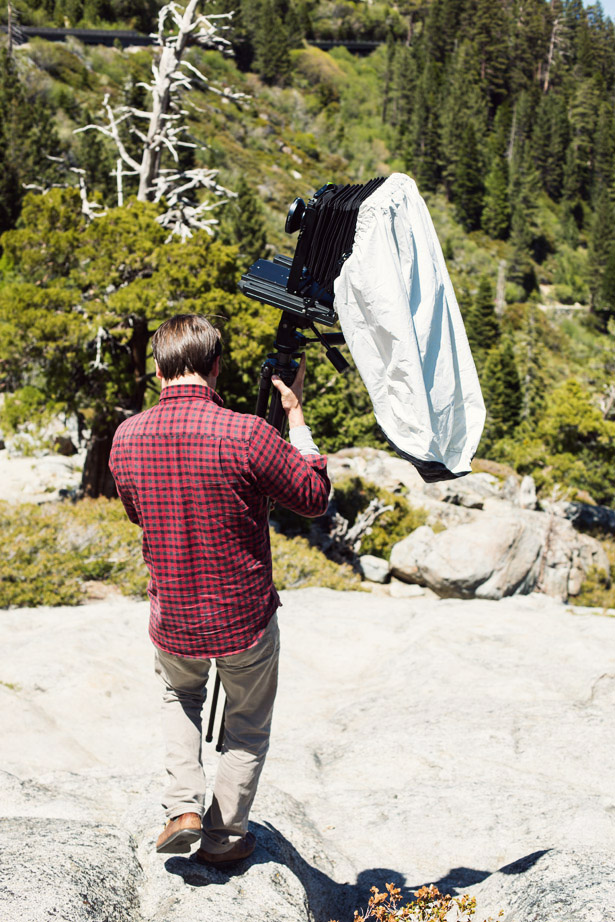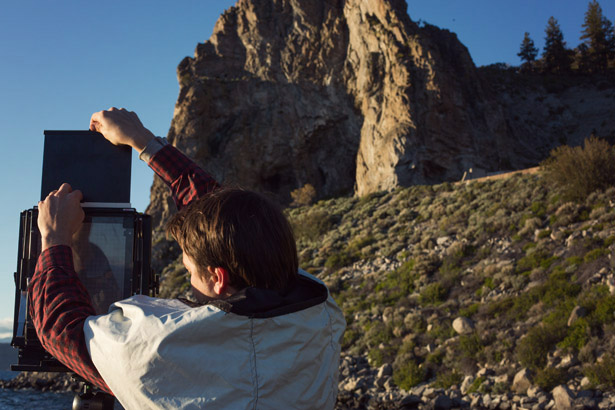[Y]ou do not want to put Adam and I across from each other at a dinner table too often because we will close a restaurant talking about photography, photographers, film vs. digital, the meaning behind photographs, technical process, how people experience photographs as art, who, in the history of photography, were influential in changing the dialogue in which we communicate through images and how technology is constantly changing photography everyday.
Back this past summer we were on a location shoot in Lake Tahoe with a client that has since become a wonderful friend and her husband who is a photographer was preparing for his first solo show in New York at the Sasha Wolf Gallery came along. It was fascinating to watch him work in the slowed down process of large format film. Of course, I immediately think of Ansel Adams, but some of his heroes are Ad Reinhardt and Hiroshi Sugimoto. In the car he kept a book of photographs from the late 1800s of the Lake Tahoe area and would study them declaring to search for “that waterfall” or point out boulders that now have tunnels cut through them. The great thing about Adam’s work is not that he creates beautiful landscape photographs but that what he sees before you is a totally new way of looking at something we’ve all seen photographed a million times and yet strangely relatable, the way your eyes adjust at night in those peaceful moments in nature.
It was such a thrill to get to see him create and now, to see the end result hanging on the walls of a gallery to be experienced. We sat down to discuss the thought behind his images, how he got to where he is now, and what’s next:
Jamie: How did the idea for the series of Night Landscapes begin?
Adam: We were on a plane back from Hawaii, flying at sunset. The sun sets really fast when you’re flying west to east. I looked away from the window for a couple of minutes and when I looked back, it was black…almost instantly dark. So I was watching the surface of the ocean and it felt like you could almost see the roundness of the Earth. I’m letting my eyes adjust and I start seeing the landscape, the earth, the way I had seen it before the sun had set. And then I realized what I was seeing – I looked again and it’s like, Wait a minute, there’s nothing there, it’s totally pitch black. And it was the memory of that landscape, not the actual landscape itself. It was almost the reflections on the window that I was imagining as the thing.
I guess I’ve just always felt like landscape photography of big places was like trophy hunting in a way: bring the biggest camera, the sharpest negative, and make these sort of gorgeous trophies to hang on your wall. But it never felt like being there…that was my first goal. I want to make pictures of the way it feels to stand in a place at night, that sort of internal feeling that you have, looking at a place and not fully seeing it.
On developing his minimalistic style:
I realized, to be able to communicate with [the viewers], I needed to make my vision as clear as possible. And the way of doing that was just stripping away everything extra. I said, What am I interested in? What is my subject? Time, birth, life, death, the cycle of life. How can I just make that? So it became stripping and stripping it down. You just have to make it really clear.
Jamie: What kind of camera are you using?
Adam: It’s a Phillips 8×10 inch camera, which all my heroes use. It’s a beautiful camera – they look antique but they’re technically very modern. Using that tool allows me a resolution that digital cameras are starting to approach. There’s a point where it’s just real-estate – I’ve got 8×10 inches of film. 80 square inches of real estate. But I tell all my students this – every single camera, mine, yours, our eyes, it’s all a light-tight box. There’s a lens on one end and a light receiving part on the other end. At the bare minimum, it’s the same thing, and everything past that is bonus.
On what makes an artist:
The premeditated print, the pre-visualization of a print. I think an artist, whether it be a painter or a photographer you have to have this sort of idea of the final product. Even if it’s Jackson Pollock, that first splatter of paint, he has some idea of what that thing on the wall is going to be like. I think that’s what does make an artist an artist is that you can see something totally banal and you have an imagination for that outcome no one else can see but you.
On film versus digital:
I say – film is only dead when they stop making film. But I think, for most commercial purposes, I’d say film is dead. And it has been for a long time. I used to work for shoots where we’d pull 40 Polaroids from a 4×5 back, and that sucked. It wasn’t fun. It was insanely expensive, and now, you can see a file there on your iPad, so why would you use film? The resolution on digital is more than enough for most magazines and things like that. But I think for fine art, when speed is not the necessity, there is validity to using film. It’s a constraint that you add to your practice, and that’s a gift!
The first digital class I teach, I’m going to have to find a memory card that only allows 30 pictures, and they have to tape up the back of the camera, they can’t look, because learning digital right now is learning without constraints, without limitation. And I think digital – it works for people who already know what they’re doing. But for people who are learning, it’s distracting you from what you need to know, which is the interaction with the camera.
Jamie: Who are your heroes? Who inspires you?
Adam: Oh, wow…for photographers? Carleton Watkins, Hiroshi Sugimoto, Emmet Gowin, and Uta Barth. As far as other artists – Ad Reinhardt, Mark Rothko, Vija Celmins, James Turrell, Robert Irwin. And I love the music of Steve Reich, Philip Glass, and Brian Eno.
At MassArt, in junior year, I took a view camera class and…people made their best pictures with the view camera. And it wasn’t that it was better resolution, I mean, that was a nice bonus…but it was that they slowed down. That they had eight shots. That it was a ton of money. And that there was something at stake, versus the speed of shooting with digital.
[After his class]: A lot of people buy view cameras. Some go back to their digital cameras, but their work? Oh my god, their work with the same camera they started with is so much better. It’s the act of knowing what a good print and what a good image looks like.
J: What was your first photograph?
A: Oh, this is a good story! It’s with a K1000. I was going to Walden Pond – perfect, right? – the place where Thoreau wrote Walden, and one of my good friends had a K1000, and I said, “Take a picture of that. Take a picture of that. Take a picture of that.” And he was like, “Stop! That’s not a good picture. Why would I take that picture?” And so finally at the end of the day he gave me the camera and said, “Take it out for the day. Here’s a roll of film, go make some pictures. By the way, sometimes the film gets stuck, here’s what you do.”
I went out, and it was one of the best days of my life. It validated walking. It validated looking. It was this reason to wander and to just look at the world and observe. That was the thing that I loved!
The best part was, I started rewinding it, and sure enough, I hear that noise. And I said, “Oh, okay,” so I open up the back of the camera and I start pushing the film into the canister. I’m just watching it go in, and then I close up the back. And I shoot another roll of film, and it does the same thing, so I just push the film back in again. So I brought it back and I said, “It was amazing, Justin…I took a picture of this, that, everything.” And he was like, “Did it jam up on you?” And I said, “Yeah, but it was no problem, I just pushed it back in.” And he said, “You pushed it back in, what do you mean?” And I’m like, “Yeah, I pushed it back into the canister.” And he goes, “You saw the film?” and I said, “Yes, I saw the film.” And so he said, “Give me the roll,” and he just threw it in the garbage.
I had no idea that it was a light-sensitive, fragile thing. It just didn’t occur to me. And that was it – that there was this two part process: this act of looking and observing, and then this technical part, this magic that you couldn’t fully understand or control but you could potentially harness. And that’s what I love about it still – it’s looking and it’s harnessing technology. It’s recording sight, recording what the world looks like.
Below – his wife Amy showed me Adam’s “Dexter Tent” he built in their backyard in Palto Alto where Adam brings his prints for their final step…
Adam: For me to get these images to be the way they are now is by bringing them into a spray booth, lacquering them, letting them cure…I mean, they become sort of handmade in a way that I never anticipated them to be. You want to make pictures of the night…and I could now professionally paint a car. Or professional spray tanning, which is what the spray gun is supposed to be for.
Jamie: So what’s next?
Adam: COLOR…but very gray colors, let’s be honest.
You can see Adam’s work here if you are in New York, you can learn from Adam here if you are in California, and you can talk to him yourself this Saturday at the gallery walk through from 3-4pm…I highly recommend it.



